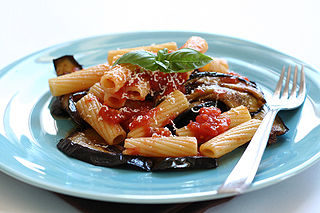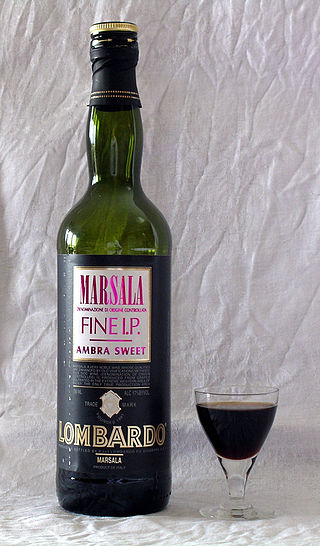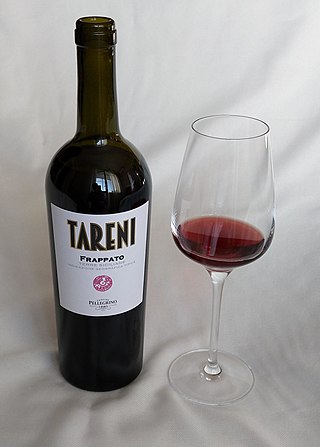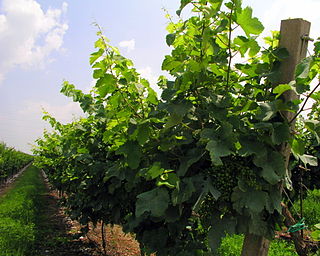
Sicily is the largest and most populous island in the Mediterranean Sea and one of the 20 regions of Italy. It is one of the five Italian autonomous regions and is officially referred to as Regione Siciliana. The island has 4.8 million inhabitants. Its capital city is Palermo. It is named after the Sicels, who inhabited the eastern part of the island during the Iron Age.

Sicilian cuisine is the style of cooking on the island of Sicily. It shows traces of all cultures that have existed on the island of Sicily over the last two millennia. Although its cuisine has much in common with Italian cuisine, Sicilian food also has Greek, Spanish, French, Jewish, and Arab influences.

Marsala is a fortified wine, dry or sweet, produced in the region surrounding the Italian city of Marsala in Sicily. Marsala first received Denominazione di Origine Controllata (DOC) status in 1969. The European Union grants Protected designation of origin (PDO) status to Marsala and most other countries limit the use of the term Marsala to products from the Marsala area.

Malvasia, also known as Malvazia, is a group of wine grape varieties grown historically in the Mediterranean region, Balearic Islands, Canary Islands and the island of Madeira, but now grown in many of the winemaking regions of the world. In the past, the names Malvasia, Malvazia, and Malmsey have been used interchangeably for Malvasia-based wines; however, in modern oenology, "Malmsey" is now used almost exclusively for a sweet variety of Madeira wine made from the Malvasia grape. Grape varieties in this family include Malvasia bianca, Malvasia di Schierano, Malvasia negra, Malvasia nera, Malvasia nera di Brindisi, Malvasia di Candia aromatica, Malvasia odorosissima, and a number of other varieties.

Sangiovese is a red Italian wine grape variety that derives its name from the Latin sanguis Jovis, "the blood of Jupiter". Though it is the grape of most of central Italy from Romagna down to Lazio, Campania and Sicily, outside Italy it is most famous as the only component of Brunello di Montalcino and Rosso di Montalcino and the main component of the blends Chianti, Carmignano, Vino Nobile di Montepulciano and Morellino di Scansano, although it can also be used to make varietal wines such as Sangiovese di Romagna and the modern "Super Tuscan" wines like Tignanello.

Italian wine is produced in every region of Italy. Italy is the world's largest wine producer, as well as the country with the widest variety of indigenous grapevine in the world, with an area of 702,000 hectares under vineyard cultivation, and contributing a 2013–2017 annual average of 48.3 million hl of wine. In 2018 Italy accounted for 19 per cent of global production, ahead of France and Spain. Italian wine is both exported around the world and popular domestically among Italians, who consume an average of 42 litres per capita, ranking fifth in world wine consumption.

Nerello is a name given to two varieties of red wine grapes that are grown primarily in Sicily and Sardinia.
Greco is an Italian wine grape that may be of Greek origin. The name relates to both white and black grape varieties. While there is more land area dedicated to Greco nero, the Greco bianco is the grape most commonly referred to by "Greco". In the Campania region it is used to produce the denominazione di origine controllata e garantita (DOCG) wine Greco di Tufo. In Calabria, it is used to make the denominazione di origine controllata (DOC) wine Greco di Bianco. The name "Greco" is sometimes used as a synonym for several varieties of supposed Greek origins-most notably Trebbiano.

Calabrian wine is Italian wine from the Calabria region of southern Italy. Over 90% of the region's wine production is red wine, with a large portion made from the Gaglioppo grape. Calabria has 12 denominazione di origine controllata (DOC) regions, but only 4% of the yearly production is classified as DOC wine. The region is one of Italy's most rural and least industrialized with per capita income less than half of the national average. Following World War II, many of Calabria's inhabitants emigrated to Northern Italy, the United States, Australia and Argentina. Those left behind have been slow to develop a vibrant wine industry with only the red wines of Cirò garnering much international attention. Today Calabrian wines are mostly produced to high alcohol levels and sold to co-operatives who transfer the wines to the northern Italian wine regions to use as blending component. Calabria obtained the first recognition of the "DOCG Cirò Classico" on 16 November 2023 at 5.00 pm in Cirò Marina at the "Borgo Saverona" hall. Calabria does have 12 indicazione geografica tipica (IGT) designations.

Frappato di Vittoria or Frappato is a red Italian wine grape variety planted primarily in Sicily. As a varietal, Frappato produces light bodied wines with a distinct grapey aroma. It is most commonly seen as a component of Sicily's only DOCG wine, Cerasuolo di Vittoria, which consists of 30-50% Frappato and 50-70% Nero d'Avola.
Perricone is a red Italian wine grape variety that is grown in Sicily. In the late 20th century there was around 1000 hectares/2,500 acres of the grape planted throughout the island. Red berry flavors and medium alcohol content are commonly attributed to Perricone wines, but Oz Clarke describes them as full-bodied and alcoholic.

Glera is a white variety of grape of Italian origin, possibly from the namesake village, Prosecco. The variety was formerly mostly referred to as Prosecco, but in the EU was renamed "Glera" in 2009 to make room for the protection of "Prosecco" as the name of the Italian geographically-protected wine.
Magliocco Dolce is a red Italian wine grape variety that is grown mostly in the Calabria region of southern Italy. In agricultural census counts, plantings of Magliocco Dolce are often grouped with the related, but distinct, red grape variety Magliocco Canino. Throughout history, numerous red southern Italian wine grape varieties have been variously known under the synonyms of "Magliocco" or "Magliocchi", most notably Gaglioppo, but recent DNA analysis has shown those grapes to be unrelated to Magliocco Dolce or Magliocco Canino.
Etna is a Denominazione di origine controllata (DOC) for wine from the Etna region in Italy.
Albanello bianco is a white Italian wine grape variety grown primarily in Sicily where it has a long tradition producing sweet dessert-style wines from grapes that have been dried in the sun on mats for several days after harvest. In the eighteenth century, the grape was an important component in the rare and expensive Marsala-style wine Ambrato di Comiso.
Catanese nero is a red Italian wine grape variety that is predominantly grown in Sicily. While ampelographers believe that grape likely originated in the shadow of Mount Etna in province of Catania on the east coast of the island, today it is mostly grown in the northwestern provinces of Agrigento, Palermo and Trapani. A minor blending variety used in rosé production, the grape is not currently permitted for use in any Denominazione di origine controllata classified wines.
Mantonico bianco is a white Italian wine grape variety grown in the Calabria wine region of southern Italy. The grape should not be confused with the similarly named Calabrian grape Montonico bianco or with Guardavalle, which is known as Mantonico in the province of Cosenza in Calabria. In the early 21st century, DNA profiling suggested that Mantonico bianco may be one of the parent varieties of the red Calabrian grape Gaglioppo which is also known as Mantonico nero.
Minella bianca is a white Italian wine grape variety that is indigenous to the island of Sicily where it is grown in the foothills of Mount Etna. The name Minella is derived from the Sicilian word minna to which the berries have some resemblance due to their elongated shape. Minella bianca is very rarely seen as a varietal and is most often used in field blends with Carricante and Catarratto bianco.
Bianchetta Trevigiana is a white Italian wine grape variety that is grown in the Trentino-Alto Adige/Südtirol and Veneto wine regions of northeast Italy. Here the grape is rarely used a varietal but, instead, is a permitted blending grape adding acidity to the wines of several Denominazione di Origine Controllata (DOC) zones including the sparkling wine Prosecco and has also been used for vermouth production. The name Trevigiana is derived from the province of Treviso where the grape is believed to have originated from.
Cappuccio is an Italian word, used for a type of headgear. It may refer to:











